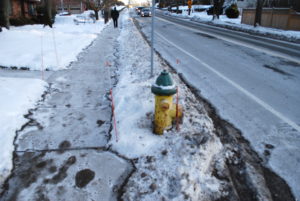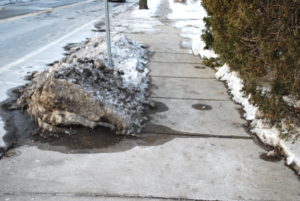Pavement and Policy in Belmont
by Kate Bowen

Hell strips separate traffic from pedestrians. But in the winter, because of the snow, the strip expands, and the walkable area decreases. The photo above is from just a two-inch snowfall. After the January 4 blizzard, with four-foot drifts, there was almost nowhere to walk in some neighborhoods but in the streets. (John DiCocco photo.)
In 2015, I wrote a story for this newsletter on “hell strips,” those swaths of dirt between the sidewalk and the street, where water-thirsty plants die and well-suited natives thrive. To recall the benefits, these planted strips cool streets in the heat. They provide filtration of fine particulate matter making sidewalk areas healthier. They provide food for birds and insects, and hold snow in winter. And, they delineate the vehicle travel/parking lane from the sidewalk area. This last function has become most important to me.
In 2016, Bartlett Avenue, where I live, was scheduled to be reconstructed. It had a score of 33 out of 100 on the Pavement Condition Index, as well as recurring gas leaks. This presented the moment to restore my own hell strip, which was merely a patchwork of various asphalt mixes and conditions. Restoring the strip would also necessitate adding a curb.
When a road is planned for reconstruction in Belmont, the abutting homeowner is informed by letter from the town of the basic timeline and the option to pay for curbs. Per town policy, sidewalks and curbing are not part of routine road reconstruction. If you have the town do the curbing work, you have the option of granite curbing only. The town provides an estimated price per foot based on recent history, with a final price given after construction. Other types of curbing can be arranged by the homeowner at their own cost. Curbs, even modest ones, help retain the soil and direct stormwater. They also indicate where cars can park much more effectively than paint.
When a road is planned for reconstruction in Belmont, the abutting homeowner is informed by letter from the town’s contractor of the basic timeline and the option to pay for curbs.
Hell strips can be further reduced by poorly cropped shrubs, cars not fully parked in a driveway, or the lack of a stone curb. (John DiCocco photo.)
Consequences of Sidewalk Policy
The sidewalk policy was created in 2007 by a vote of the Board of Selectmen. In a board meeting this fall, Selectman Mark Paolillo recalled, “[The vote] was a solution agreed on by that board following a failed override for the comprehensive road repair plan. The logic then was that by removing sidewalk repairs and curbing from the plan, the vehicle areas of the roads could be reconstructed faster.” For a very poor road, the sidewalks could account for as much as 40% of the total road budget. The 2007 policy did not take into account pedestrian safety and the varied and different needs of transit by neighborhood.
The policy likewise did not place any restrictions on paving over grassy buffers.
A Matter of Safety
Over time, on roads like Bartlett, in the absence of guidelines to retain planted spaces, these grassy areas have been lost. In recent conversations with my neighbors, they recalled trees that were not replaced because the abutting homeowner (in residence or not) preferred asphalt to park their car. Remember, this is the sidewalk area, not a travel lane. In a Safe Routes to Schools walk assessment in 2015, the Department of Public Works expressed a preference for pavement over grassy buffers, which may account for the prevalence.
For the many streets without curbs, the grassy buffer is the only definition between the road and the sidewalk. Without it, sidewalk safety and accessibility is routinely compromised by vehicles parked partially or fully on the sidewalk. Likewise, speeds increase with road width. For short roads or dead ends with little daily traffic and slow speeds, sidewalks may not be necessary. Longfellow Road in Cambridge, about 300 feet long, is an example of this “shared street” design model.
Bartlett, for one, should not be a “shared street” in today’s environment. It is longer and connects several shorter neighboring streets. It also serves as an elementary school walking route, has several school bus stops, leads to one of the highest boarded stops on the MBTA bus route #73 (a top 10 MBTA route), and welcomes users to Pequossette Park. It sees a lot of foot and vehicle traffic, so clear separation between roadway and sidewalk is necessary for safety.
For streets without curbs, the grassy buffer is the only definition between the road and the sidewalk.
Balancing Road Use
Once upon a time, most Belmont streets existed like “shared streets” by default; cars were fewer and slower. Trees were abundant, as were pedestrians and bikes. The desire to have that balance hasn’t left. In May 2017, Town Meeting adopted the 25 mph town-wide speed limit, a significant reflection of the safety risks presented by vehicular traffic.
With $200,000 from the 2015 override annually allocated to sidewalk repair, the DPW had a sidewalk assessment to prioritize repairs. The assessment includes not only the pavement condition, but also accounts for curbs, grassy strips, accessibility, and circumstances that generate pedestrian use. People typically walk to places within a half mile of their home or work. Of the 97 miles of existing sidewalk in Belmont, 54 miles had curbing, and 47 had only grassy buffers.
This left seven miles of streets without any physical delineation or separation between cars and pedestrians. With the study in hand, the support of the selectmen, and residents requesting action for safer sidewalks, the Office of Community Development took the opportunity to review the 112 reconstructed roads of the past 10 years. Of those roads, several were in these seven miles lacking pedestrian protection and in the poorest condition. Six were part of safe walking routes to schools. Five of those six directly serve the Daniel Butler Elementary School; one serves Belmont High School.
Recognizing these factors anew, the selectmen voted to address the pedestrian safety on these six roads annually as funding allows, Bartlett among them. Their decision marks an important awareness of the need to accommodate all modes of travel and to revise the existing sidewalk policy.
While the Board of Selectmen works to redress the failings of the 2007 policy, they may also look to the Complete Streets program for guidance.
People typically walk to places within a half mile of their home or work. Of the 97 miles of existing sidewalk in Belmont, 54 miles had curbing, and 47 of those had only grassy buffers.
Towns that join the Complete Streets program are eligible for immediate technical assistance funds and improvement grants. Complete Streets seeks to address the needs of all users and balance them, as they vary from neighborhood to neighborhood. This is a return to our not-so-distant roots that balanced foot, train, car, bike, and streetcar uses.
When the dust has settled, I’ll be planting privet in my hell strip. And, no doubt, crabgrass, for which I have a new affection. Privet, trimmed low to comply with visibility needs, provides a great buffer, holds up to large amounts of snow, and is low maintenance. Like walking, this choice harkens back to earlier days of Belmont, in a way I can live with.
Kate Bowen is a Town Meeting and School Committee member, and a former chair of Sustainable Belmont.



Sorry, the comment form is closed at this time.